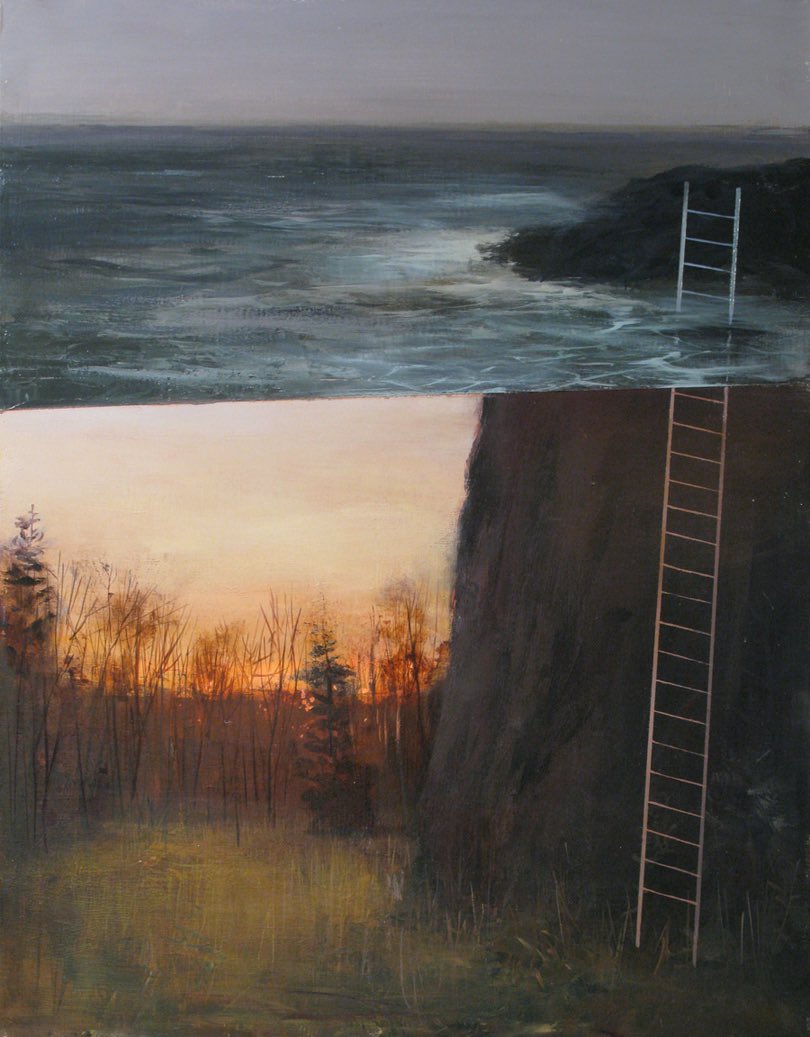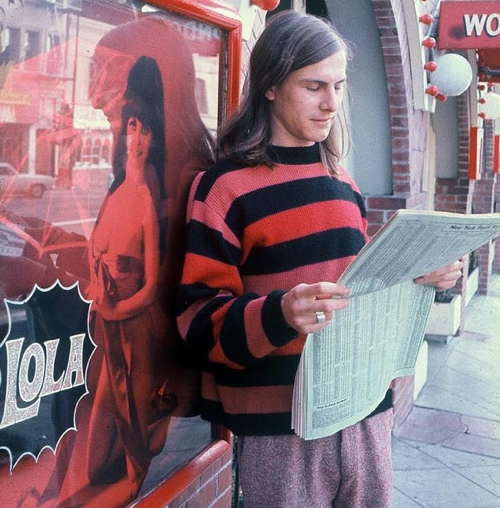
Upstream they’ve allowed the water level of the river to fall until the dam’s top blocks can be seen as the waterfall retreats. The river’s bottom emerges and a spring shorebird skitters along the edge of the green muck, its beak probing the dirt. Three pigeons pace on and peck at the drying granite blocks. Each block in the slightly curved dam wall under their feet is an easy ton of stone. The dam spans the river and, when the water is allowed to rise, it vanishes under a sheen of falling water. But now the water is low even though the river still flows.
Behind the dam a grating of steel bars lets the river flow under the dam and gush out the spill pipe at the foot of the stone blocks. There the river continues to flow under the footbridge, between the stone and brick walls of the mill, over another waterfall further on, and then, past other mills still downstream, out to sea.
The mill holds the river tight between its walls for a short span and, in the past, the dipping, turning wheels would have spun drawing the river’s power into the mill and, through rods and pulleys, relayed it on to the machines.
The first mill at this turn of the river was a saw mill in 1649. Then a grist mill came in its place. In time that too was torn down and the granite and brick buildings here now were raised up. The mill rises above the river, five stories of brick set on many courses of granite foundation stones. In its current form the mill made fabrics from civil war uniforms to fine cashmeres. Another mill just downstream made munitions for our arsenals. One gun from those foundries and lathes went first north to Portland and later west out over the ocean to Pearl Harbor. Later that mill’s machines made other parts out of case-hardened steel and pig iron. Other products, over the years, came from the mill: Christmas tree ornaments, cameras and film, paint, ice creepers for the Russian troops during World War II, rifle grenades, ski poles, waterproof boxes, and wooden shoes.
Today those machines are gone. Today the mill houses those who admire the fashionability of loft-like apartments; who value the anonymity of its corridors and numbered doors.
On massive granite blocks the mill as it now is has straddled the river for over a century. With care and maintenance its good for another century — or two or three — even though its use then cannot be foreseen anymore than the builders of the mill would have thought in their day that they were building housing.
The men who built the mill built better than they knew; far better than the Frank Lloyd Wright fancy “Falling Water,” once lauded by all but now already being rotted out and reclaimed by the stream it enfolded. The mill was not built as a fancy but as a machine for making and now for living, built to last by men whom we cannot hope to emulate.
In full spate the river surges between the mill’s walls and, at times, rises to flood the lowest apartments much to the distress of its fashionable tenants.

At flood speed the river rushes beneath the lower windows with a rumble and a stifled roar as if some endless ghost freight train was passing, passing, passing.
But then the spring flood abates to the hushed rustle and hum of flow. Over the calmer water swallows daub their nests under the eaves and, at dusk, dart and flicker over the water. And the mill around them, built long ago on the rocks of capital, skill, muscle, sinew and faith, contains the river below and the spring sky seen in its surface. The mill, raised on granite and formed from fire-forged bricks laid one after the other by arm and hand, mortar and trowel, built to last, endures.
Today we live in the reflection of their times. Today we taste the afterimage of events.




![That Was the Whopper Weekend That Was [Illustrated] welcometohell](https://americandigest.org/wp/wp-content/uploads/2021/05/welcometohell-150x150.jpg)





 Gerard Van der Leun
Gerard Van der Leun
























Comments on this entry are closed.
Massachusetts?
New Hampshire. But close the Mass line.
Surely it’s occurred to someone, at least since they’ve turned the place residential, to maybe brick up those windows down at flood level?
Perhaps, but there are at least 40 – 50 apartments with rooms on that level so I don’t think the Mill could survive financially if it lost those apartments for good.
I drove around Massachusetts last year. There’s a lot of buildings like that one, many repurposed.
We owe “small, medium, large” to mills like that during the Civil war. The union’s military supply folks came up with premade, sized uniforms to save time and money.
‘
A couple of weeks ago I visited the partially-restored Slater Mill in Pawtucket RI. Worth a trip.
My fav is the old gristmill at Spring Mill state park near Mitchell, Indiana. It’s surrounded by an entirely restored village from the early 1800’s, complete with a tannery, spinning wheels, tavern, inn, apothecary, and a whole lot more. Nearby in the park is a museum of Gus Grissom’s space history including one of the Mercury space capsules. Great place to take the family to unwind for a few days!
http://www.in.gov/dnr/parklake/6597.htm
My first thought was that this was Maynard, Mass – the former mills, then revitalized as the HQ of DEC, now Monster.com. It looks exactly like this.
Concord also has a lot along the river that flooded badly in the spring of 2010. Somewhere I have a picture of the Bridge where “the shot heard ’round the world” was heard – half under water. The downtown was worse.
And let it attracts Yuppies like a moth to a flame.
Moths to a flame is apt. We see the same thing in Minneapolis and St. Paul. Convert an old warehouse or manufacturing plant into condos, and the Millennials are drawn in. We lack the charming little river, but we have a charmless big river a short walk away. It has not flooded anything other than parkland near here for decades.
Water runs downhill and seeks the path of least resistance.
With proper grading, drainage, and foundation wall waterproofing, there is no problem here.
I routinely design buildings that are subject to potential massive saltwater flooding. And extremely high swirling wind velocities at the same time. Learning is a constant.
I’m sure GS is correct about the problem being solvable.
I’m pretty sure that these are deemed “historic buildings” where the local filth p[revent it from being solved.
these are deemed “historic buildings”
================
In the bidnit we call them “The Hysterical Society”.
They are generally run by frantic women and cucked men and suffer no consequences for their actions. Experienced professionals run circles around them every day.
Conversation overheard on a jobsite a month or so ago, between a superintendent and a project manager.
“We didn’t find any dinosaur bones today, and we stashed them in the same place we stashed the ones we didn’t find yesterday and last week, too.” Yes indeed, experienced professionals know how to get things done.
Ford had a plant in a western ohio town with a hydroelectric powerplant fitted with equipment from the James Leffell Company, also in ohio.
time passed long after it was in use, and the city that owns it wanted to, IIRC, turn the powerhouse into a piece of the towns history. Leffell, still in business, stepped in and assessed the equipment could be refurbished, modernized a bit, and produce electricity still. so the building was restored, it is a museum of sorts, and performs admirably as a power source.
Leffell at one time made a small pelton wheel turbine to serve farms, smaller applications, etc. there was an article in the Second Whole Earth Catalog concerning it, so I mailed away for the info and recieved it from them, sent from cincinnatti. I was 19, IIRC.
my work would place me in central park on occasion to install scenery or rigging for film shoots. the governing group was, I believe, the Central Park Conservancy, who were on us like a rash right there in real time, very much as is said here as quoted from GS above-
“In the bidnit we call them “The Hysterical Society”.
They are generally run by frantic women and cucked men and suffer no consequences for their actions.”
Those are the Sawyer Mill apartments in Dover NH.
Here’s a video from inside.
https://www.youtube.com/watch?v=tSP_6ntzl20
The diff between entrenched do-nothings and us experienced professionals is they do the bare minimum and still get raises and promotions but we have to earn our money every dam day. We don’t get paid for failure. Success is the lifeline that connects to the future food that might be on our table tomorrow. We have a vested interest in seeing the job done right. The entrenched realize they produce nothing worthwhile and turn bitter inside making their existence that much more despicable.